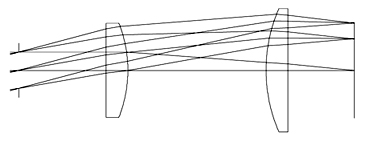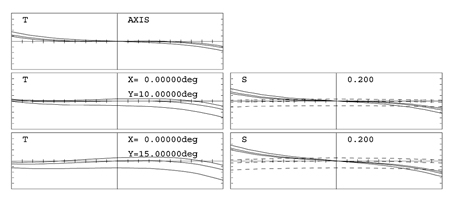The simplest eyepiece, beyond a single lens, is the Ramsden, with two singlets, as shown in Fig. 11.3. The color correction is limited to the choice of the two glasses. Naturally the performance is poor, and the example is included only as an introduction to eyepieces. Realistically, this type of eyepiece would rarely be used at these apertures. Remember that in these drawings the eye position is to the left of the drawing, and the intermediate image is on the right. This can often cause confusion!

Note that the eye relief (12 mm) is about half the focal length, which is reasonable but not as good as more complex eyepieces to be described later in these notes. Transverse ray aberrations for this design are shown in Fig. 11.4.
With two single lenses, spherical aberration and axial color are not correctable. And with this configuration, lateral color (evident in the separation of the tangential curves at the origin for 10 and 15 deg) is not correctable. Also, as we have noted in the previous chapter, the Petzval sum is not correctable in any type of simple eyepiece with two positive lenses.
M. J. Kidger, Fundamental Optical Design, SPIE Press, Bellingham, WA (2001).
View SPIE terms of use.


